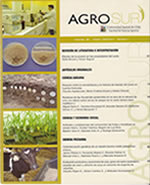Plasma frío atmosférico para el control de microorganismos patógenos en sistemas agroalimentarios
Contenido principal del artículo
Resumen
El plasma frío atmosférico (PFA) ha generado gran interés en el área industrial y en la comunidad científica, puesto que presenta valiosas propiedades, como lo son su simplicidad operativa, su bajo costo de funcionamiento, y su respeto por el medio ambiente. El PFA se puede generar a partir de varios gases (aire, nitrógeno, helio, argón) y por diferentes métodos. Sus aplicaciones abarcan múltiples áreas, como medicina, electrónica, ciencia de alimentos y agricultura, entre otros. Una de las principales características del PFA, es su capacidad de eliminar microorganismos patógenos, a través de la generación de radicales libres, los cuales disrumpen las membranas de las células y generan su apoptosis. Debido a esto, diversos investigadores han determinado los efectos de tratamientos con PFA sobre diferentes productos alimentarios, de origen vegetal y animal, contaminados con microorganismos patógenos. En general, se ha encontrado que PFA reduce significativamente la carga microbiológica de diferentes alimentos, sin afectar en la mayoría de los casos sus propiedades nutricionales y calidad. Lo que demuestra que el PFA es una herramienta innovadora y eficaz en la utilización para la inactivación de microorganismos en productos alimentarios.

